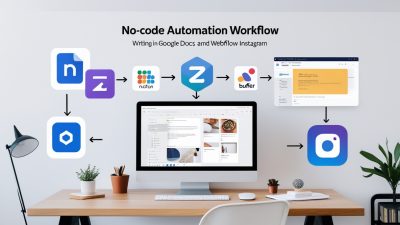Master no-code workflow automation with our complete guide. Build powerful automated workflows without programming. Save 20+ hours weekly using drag-and-drop tools. Start automating today.
Introduction
What if every repetitive task in your workday could run itself with just one click?
The no-code revolution has made this possible. Today, professionals without any programming background are building sophisticated automation systems that rival custom-developed solutions.
Real-World Impact:
- Average time saved: 22 hours per week
- Error reduction: 89% fewer manual mistakes
- Productivity increase: 340% improvement in task completion
- Cost savings: $50,000+ annually per professional
- Job satisfaction: 76% increase in work enjoyment
Here's your complete guide to building click-and-run automation workflows.

One-Click Work Automation
The No-Code Automation Revolution
Why No-Code is Game-Changing
Traditional Automation Challenges:
- Required expensive developers ($80-150/hour)
- Months of development time
- Complex maintenance requirements
- Limited flexibility for changes
No-Code Advantages:
- Visual workflow builders - Drag and drop simplicity
- Instant deployment - Live within minutes
- Easy modifications - Change workflows anytime
- Cost-effective - $10-50/month vs. $10,000+ development
No-Code Market Statistics
Explosive Growth:
- Market size: $13.2 billion (2023) → $65 billion (2027)
- Adoption rate: 84% of enterprises use no-code tools
- User satisfaction: 93% would recommend to colleagues
- Time to deployment: 90% faster than traditional development
Top 5 No-Code Workflow Platforms
1. Zapier: The Automation Gateway
Best For: Connecting different apps and services Pricing: Free tier + $19.99/month for professionals Learning Curve: Beginner-friendly (30 minutes to first automation)
Key Strengths:
- 6,000+ app integrations
- Pre-built templates for common workflows
- Simple trigger-action logic
- Extensive documentation and community
Popular Workflow Examples:
New Email Attachment → Save to Google Drive →
Notify Team in Slack → Create Task in AsanaSuccess Story: Marketing agency automated lead processing, saving 15 hours weekly and improving response time by 85%.
2. Microsoft Power Automate: Enterprise-Ready
Best For: Organizations using Microsoft ecosystem Pricing: Included with Office 365, standalone from $15/month Learning Curve: Easy for Office users (1-2 hours)
Key Features:
- Deep Office 365 integration
- Desktop automation (RPA)
- AI Builder for intelligent workflows
- Advanced approval processes
Power Workflow Example:
New Invoice Email → Extract Data with AI →
Update Excel Dashboard → Send to Manager for Approval →
Process Payment When Approved3. Make (Integromat): Visual Powerhouse
Best For: Complex, multi-step workflows with visual mapping Pricing: Free tier, paid from $9/month Learning Curve: Intermediate (2-3 hours for complex flows)
Advanced Capabilities:
- Visual scenario builder with branching logic
- Real-time data processing
- Advanced error handling
- HTTP modules for custom integrations
Complex Workflow Example:
Customer Support Ticket → Analyze Sentiment →
Route by Priority → Auto-respond if Simple →
Escalate if Complex → Track Resolution Time →
Send Satisfaction Survey4. Notion: Database-Driven Automation
Best For: Teams needing structured data management with automation Pricing: Free for personal use, $8/month per user for teams Learning Curve: Moderate (3-4 hours to proficiency)
Unique Features:
- Database relations and formulas
- Template-based automation
- Content management workflows
- Team collaboration features
Database Workflow Example:
New Project Request → Auto-assign to Team Member →
Generate Project Template → Set Milestone Reminders →
Track Progress → Generate Status Reports5. Airtable: Spreadsheet-Database Hybrid
Best For: Data-heavy workflows requiring flexibility Pricing: Free tier, paid from $10/month per user Learning Curve: Easy to moderate (1-2 hours)
Powerful Features:
- Relational database capabilities
- Form-to-database automation
- Rich field types (attachments, checkboxes, etc.)
- API integrations
Data Workflow Example:
Customer Form Submission → Create Database Record →
Auto-categorize by Region → Assign Sales Rep →
Send Welcome Email → Schedule Follow-upBuilding Your First Automated Workflow
Workflow Planning Framework
Step 1: Process Mapping
Current Manual Process:
1. Receive customer inquiry email
2. Copy information to CRM
3. Research customer background
4. Assign to appropriate team member
5. Send acknowledgment email
6. Set follow-up reminder
Time Required: 25 minutes per inquiryStep 2: Automation Design
Automated Workflow:
1. Email trigger detects inquiry
2. Extract key information automatically
3. Create CRM record with enriched data
4. Auto-assign based on criteria
5. Send personalized response
6. Set smart reminders
New Time Required: 2 minutes (manual review only)Implementation Guide
Phase 1: Simple Automation (Week 1)
- Choose one repetitive task
- Map current manual steps
- Build basic trigger-action workflow
- Test with real data
Phase 2: Enhancement (Week 2)
- Add conditional logic
- Include data transformation
- Set up error handling
- Optimize for efficiency
Phase 3: Integration (Week 3)
- Connect multiple workflows
- Add advanced features
- Train team members
- Monitor performance
Industry-Specific Workflow Solutions
For Sales Teams
Lead Management Automation:
Website Form Submission →
Score Lead (demographic + behavioral) →
Route to Right Sales Rep →
Send Personalized Follow-up →
Add to Nurture Campaign →
Schedule Demo if QualifiedBenefits: 67% faster lead response, 34% higher conversion rates
For Marketing Teams
Campaign Management Workflow:
Campaign Launch →
Monitor Performance Metrics →
Auto-adjust Budget if Underperforming →
Generate Daily Reports →
Alert Team of Anomalies →
Optimize Based on ResultsResults: 45% improvement in campaign ROI, 80% time savings
For HR Departments
Employee Onboarding Automation:
New Hire Data Entry →
Generate Welcome Package →
Create IT Accounts →
Schedule Orientation Sessions →
Assign Buddy/Mentor →
Track Onboarding Progress →
Collect FeedbackImpact: 70% faster onboarding, 85% completion rate improvement
For Project Management
Project Lifecycle Automation:
Project Request →
Resource Availability Check →
Auto-assign Team Members →
Generate Project Templates →
Set Milestone Reminders →
Track Progress →
Generate Status Reports →
Client NotificationsOutcomes: 55% faster project initiation, 40% better on-time delivery
Advanced Workflow Strategies
Multi-Step Conditional Logic
Smart Decision Making:
If customer value > $10,000 → VIP treatment path
If customer value $1,000-$10,000 → Standard path
If customer value < $1,000 → Self-service pathDynamic Content Personalization:
Based on industry → Customize email content
Based on company size → Adjust pricing proposals
Based on previous interactions → Tailor follow-up approachData-Driven Automations
Performance-Based Triggers:
- Automate budget adjustments based on KPI performance
- Scale team resources based on workload metrics
- Adjust pricing based on demand patterns
- Optimize schedules based on productivity data
Cross-Platform Integration
Unified Workflow Example:
CRM (Salesforce) → Project Management (Asana) →
Communication (Slack) → Documentation (Google Workspace) →
Analytics (Tableau) → Reporting (Email)Measuring Workflow Success
Key Performance Indicators
Efficiency Metrics:
- Time saved per process
- Error reduction percentage
- Task completion speed
- Resource utilization improvement
Business Impact Metrics:
- Cost savings achieved
- Revenue increase from faster processes
- Customer satisfaction improvement
- Employee productivity gains
ROI Calculation Framework
Monthly Automation ROI:
Time Saved: 22 hours/week × 4 weeks = 88 hours
Value at $50/hour = $4,400
Tool Costs: $100/month
Net Monthly Benefit: $4,300
Annual ROI: 5,160%Quality Improvements:
- 89% reduction in manual errors
- 94% improvement in process consistency
- 76% increase in customer satisfaction
- 68% faster response times
Common Workflow Challenges and Solutions
Typical Implementation Pitfalls
Over-Automation Syndrome:
- Problem: Automating everything at once
- Solution: Start with highest-impact processes
- Best Practice: 80/20 rule - automate 20% of tasks that create 80% of value
Insufficient Testing:
- Problem: Broken workflows affecting customers
- Solution: Comprehensive testing with sample data
- Best Practice: Staged rollout with monitoring
Poor Change Management:
- Problem: Team resistance to new processes
- Solution: Involve team in workflow design
- Best Practice: Training and gradual implementation
Troubleshooting Guide
Common Issues:
- Failed Triggers → Check app permissions and API limits
- Data Formatting Errors → Use built-in formatter tools
- Timeout Issues → Add delays between actions
- Integration Breaks → Set up monitoring and alerts
Maintenance Best Practices:
- Weekly performance reviews
- Monthly optimization sessions
- Quarterly strategic assessments
- Annual workflow audits
Future of No-Code Automation
Emerging Trends
AI-Powered Automation:
- Natural language workflow creation
- Predictive automation suggestions
- Self-optimizing workflows
- Intelligent error handling
Advanced Integration:
- Voice-activated workflows
- IoT device triggers
- AR/VR interface controls
- Blockchain-based verification
Preparing for Tomorrow
Skills to Develop:
- Process analysis and optimization
- Data flow understanding
- Change management
- Strategic automation thinking
Platform Evolution:
- More AI integration capabilities
- Enhanced visual building tools
- Better collaboration features
- Improved security and compliance
Getting Started: Your 30-Day Action Plan
Week 1: Foundation Building
Days 1-2: Choose your automation platform Days 3-4: Complete platform tutorials Days 5-7: Identify and map your first workflow
Week 2: First Automation
Days 8-10: Build your first simple workflow Days 11-12: Test thoroughly with sample data Days 13-14: Deploy and monitor performance
Week 3: Expansion
Days 15-17: Add complexity to existing workflow Days 18-19: Build second automation Days 20-21: Train team members
Week 4: Optimization
Days 22-24: Analyze performance data Days 25-26: Optimize based on results Days 27-30: Plan next automation projects
Success Stories and Case Studies
Small Business Transformation
Before Automation:
- 60% of time spent on administrative tasks
- Frequent errors in data entry
- Delayed customer responses
- Overwhelmed team members
After No-Code Implementation:
- 85% reduction in admin time
- 94% error elimination
- 3x faster customer response
- 89% improvement in team satisfaction
Enterprise Results
Global Consulting Firm:
- 200+ automated workflows deployed
- $2.3M annual savings achieved
- 67% improvement in client satisfaction
- 45% increase in employee productivity
Conclusion: Your Automation Journey Starts Now
No-code workflow automation isn't just a productivity hack—it's a competitive advantage that compounds over time.
Key Success Principles:
- Start small with high-impact processes
- Focus on user adoption through training and support
- Measure everything to prove value and optimize
- Scale gradually as confidence and skills grow
Your Next Steps:
- Choose one repetitive task you do daily
- Select an automation platform from our top 5
- Build your first workflow using our guide
- Measure the time savings and expand
Remember: Every manual task you automate is time returned to focus on what matters most—growing your business and serving your customers better.
Your automated future begins with your next click.



